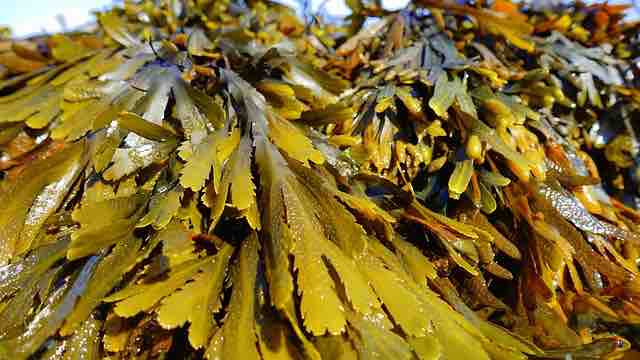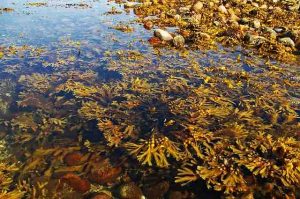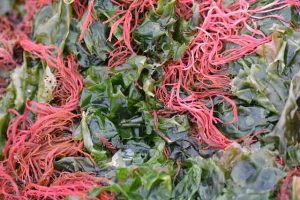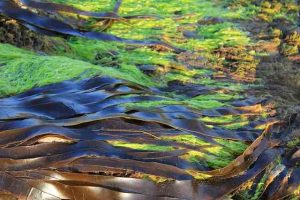 Would you like to learn how to harvest your own tasty and nutritious seaweeds along the rocky coast of the UK? With a bit of knowledge and a few tools, you can make an outing to the shore productive by gathering your own healthy sea vegetables!
Would you like to learn how to harvest your own tasty and nutritious seaweeds along the rocky coast of the UK? With a bit of knowledge and a few tools, you can make an outing to the shore productive by gathering your own healthy sea vegetables!
People have been harvesting and eating seaweeds for hundreds of years. People living in Ireland and other UK Islands were eating seaweed way before it became fashionable in high-end sushi bars. Here are a few recipes of Irish inspired cooking using seaweed. Today, we mostly eat seaweed when we consume sushi or seaweed salads. There are many ways to eat seaweeds and you will receive many amazing health benefits in consuming them. Plus, they are so delicious!
What is Seaweed?
Seaweed is actually considered a type of marine algae. It is a non-flowering plant that is called a thallophyte. Marine algae and fungi are the only two types of thallophytes. Seaweeds are classified into three categories based on their color pigmentation and these colours represent where they grow in the tidal zone. These are the three categories:
 Brown Algae: Brown algae (class Phaeophyceae) grow in deeper waters – the less sunlight there is, the darker their color is. They tend to grow large and are often found clustered together. There are about 1,800 different species of brown seaweeds, and most of know what kelp is, the most common of brown seaweeds. Kelp is usually found dried or in powder form and make great additions and toppings for rice bowls, salads, and soups.
Brown Algae: Brown algae (class Phaeophyceae) grow in deeper waters – the less sunlight there is, the darker their color is. They tend to grow large and are often found clustered together. There are about 1,800 different species of brown seaweeds, and most of know what kelp is, the most common of brown seaweeds. Kelp is usually found dried or in powder form and make great additions and toppings for rice bowls, salads, and soups.
Red Algae: Red algae (class Rhodophyta) are the most diverse and have over 6,500 species. Red seaweeds grow along the lower shoreline. Red seaweeds that we are familiar with are nori and dulse. Nori is used in making sushi rolls and is also delicious added to miso soup, or just for snacking on. Dulse is perfect to add to soups and chowder.
Green Algae: Green algae (class Chlorophyta) are beautiful, delicate seaweeds that love sunlight and can be found growing along the upper shoreline and along the rocky edge. There are approximately 1,500 species available, with sea lettuce the most common. Sea lettuce is very light tasting and is perfect add raw in seaweed salads.
How Healthy is Seaweed?
Of course, all of these wonderful and magical sea vegetables are incredibly nutritious and are considered a superfood. They are high in iron, protein, vitamins and minerals, and dietary fiber. And they have the most amazing flavours!
 Seaweeds are loaded with minerals, vitamins, antioxidants, phytonutrients, and are high in fibre. They contain Vitamins A, B, C, E, and K as well as omega-3 fatty acids and essential amino acids. Seaweeds are true superfoods! Because they are so nutrient-dense, eating seaweeds can help to flush out environmental toxins that have built up in your body. They contain alginate which has binding properties and can help to pass heavy metals and toxins from the system.
Seaweeds are loaded with minerals, vitamins, antioxidants, phytonutrients, and are high in fibre. They contain Vitamins A, B, C, E, and K as well as omega-3 fatty acids and essential amino acids. Seaweeds are true superfoods! Because they are so nutrient-dense, eating seaweeds can help to flush out environmental toxins that have built up in your body. They contain alginate which has binding properties and can help to pass heavy metals and toxins from the system.
Seaweeds are helpful in digestion. They help to release digestive enzymes and help to facilitate the metabolism of fats and can be helpful in weight loss, and because they contain large amounts of magnesium, they have a gentle laxative effect. If you find yourself needing a little extra help – try IsaMove from Isagenix. This product has magnesium which helps to supports electrolyte balance, protein synthesis, and protein creation in the body. Sea vegetables contain so many minerals, all 56 along with trace elements, and actually, have more than land plants.
How Do I Harvest Wild Seaweed?
 With a few tools, a tide chart, and some knowledge of your area, harvesting seaweed is actually quite simple. First though – always think safety!! You will need really good shoes or waterproof boots with excellent traction for walking on slippery rocks. Wearing a wetsuit in cold waters that surround the UK is highly advisable. Never go harvesting alone and always have a first aid kit on hand, you could slip and fall or cut yourself. Harvest smartly! Make sure the area where you are gathering seaweed from is in non-polluted waters and well away from towns, homes, and industrial areas.
With a few tools, a tide chart, and some knowledge of your area, harvesting seaweed is actually quite simple. First though – always think safety!! You will need really good shoes or waterproof boots with excellent traction for walking on slippery rocks. Wearing a wetsuit in cold waters that surround the UK is highly advisable. Never go harvesting alone and always have a first aid kit on hand, you could slip and fall or cut yourself. Harvest smartly! Make sure the area where you are gathering seaweed from is in non-polluted waters and well away from towns, homes, and industrial areas.
Grab a good pair of scissors and a sharp knife and harvest at low tide. This is where you must have a tide chart! Never harvest seaweeds that are just lying around the beach, you need to harvest healthy live ones. Cut the plants that are held on the rocks, and only cut about the top third, leave the rest. If you are harvesting several varieties, you may want separate bags and bucket to keep them separated in. And please harvest sustainably, pick a little here and a little there. Never harvest during the plants reproductive cycle – you want them to continue to grow! Each species varies, but in general, harvest in the late summer and fall.
Rinse the sand out of the seaweed and when you get home, give them a rinse with fresh  water. Then, hang the strands to dry in the sun. This should not take very long, depending on the weather. Once they are dry, seal them an airtight container and store in a cool, dry location.
water. Then, hang the strands to dry in the sun. This should not take very long, depending on the weather. Once they are dry, seal them an airtight container and store in a cool, dry location.
Seaweeds have been gracing our shoreline and oceans for thousands of years. They are an integral part of the eco-system and can help to keep our oceans and our bodies healthy. Harvest with respect to Mother Ocean and enjoy the many benefits that sea vegetables bring to us!

Leave a Reply